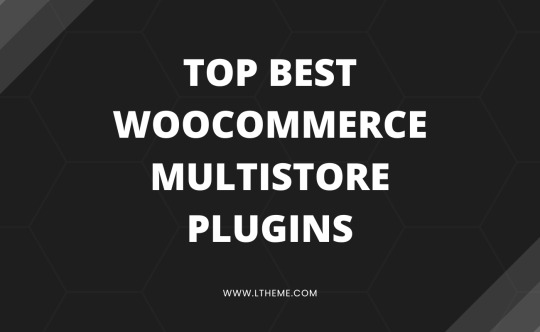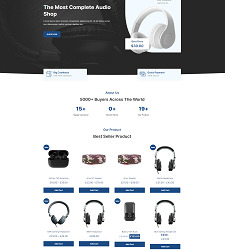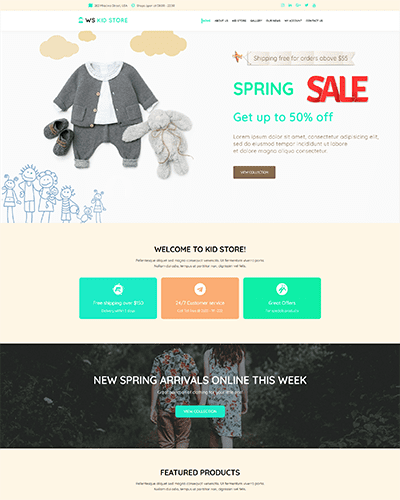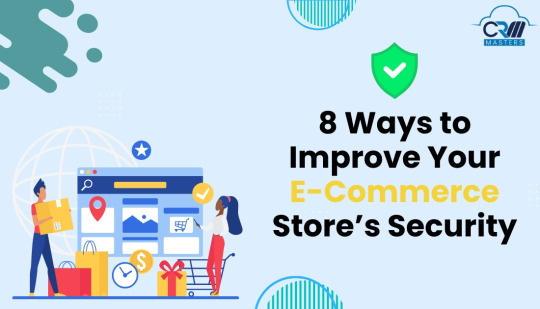#WooCommerce Custom Alerts
Text

WooCommerce WABAAPI WhatsApp Alerts: Enhance Your E-Commerce Communication
Unlock the power of instant messaging in your WooCommerce store with the WABAAPI WhatsApp Alerts Plugin. Effortlessly send customized WhatsApp order notifications, manage customer engagement, and enhance your online store's performance with our user-friendly, free plugin.
#SMSGatewayCenter#WooCommerce WhatsApp Alerts#WABAAPI Plugin#Instant Order Notifications#E-Commerce Messaging#WooCommerce India#WhatsApp Integration#Customer Engagement#Online Store Communication#WooCommerce WhatsApp Add-on#Automated WhatsApp Messages#WooCommerce Custom Alerts#WooCommerce Plugin India#sms gateway center
2 notes
·
View notes
Text
E-commerce Website Hosting and Management Solutions
With the rise of online shopping and the increasing importance of having a strong online presence, e-commerce websites have become essential for businesses of all sizes. However, building and managing an e-commerce website can be a complex task that requires specialized knowledge and resources. This is where e-commerce website hosting and management solutions come into play, providing businesses with the necessary tools and infrastructure to establish and maintain a successful online store.

Choosing the Right E-commerce Hosting Provider
The first step in setting up an e-commerce website is selecting a reliable hosting provider. A good hosting provider ensures that your website is accessible to visitors, provides fast loading times, and ensures the security of customer data. Here are some factors to consider when choosing an e-commerce hosting provider:
1. Scalability and Performance
Your e-commerce website needs to handle increasing traffic and accommodate growth over time. Look for hosting providers that offer scalable solutions and can handle high volumes of traffic without compromising performance. This ensures that your website remains fast and responsive even during peak shopping seasons or promotional events.
2. Security Measures
Security is crucial for any e-commerce website, as it deals with sensitive customer information such as credit card details. Ensure that the hosting provider offers robust security measures such as SSL certificates, regular backups, and advanced firewalls to protect against cyber threats and data breaches.
3. E-commerce Platform Support
Check if the hosting provider supports the e-commerce platform you intend to use. Popular platforms like Magento, Shopify, WooCommerce, and BigCommerce have specific hosting requirements. Ensure that the provider offers specialized hosting solutions optimized for your chosen platform, as this can significantly enhance the performance and reliability of your website.
4. Customer Support
E-commerce websites need prompt technical support, especially during critical periods. Look for hosting providers that offer 24/7 customer support through various channels like live chat, email, or phone. Responsive customer support can help resolve any issues quickly and minimize downtime, ensuring smooth operations for your online store.
E-commerce Website Management Solutions
Once you have selected a hosting provider, you also need effective website management tools to run your e-commerce store efficiently. Here are some essential features and solutions to consider:
1. Content Management System (CMS)
A robust CMS is essential for managing the content on your e-commerce website. It should allow you to easily update product information, create engaging landing pages, and optimize your website for search engines. Popular CMS options for e-commerce include WordPress, Drupal, and Joomla, each with their own strengths and capabilities.
2. Inventory Management
Efficient inventory management is crucial for e-commerce success. Look for website management solutions that provide inventory tracking, automated stock alerts, and integration with your e-commerce platform. These features help you keep track of stock levels, avoid overselling, and streamline order fulfillment processes.
3. Payment Gateway Integration
Ensure that your website management solution supports integration with popular payment gateways such as PayPal, Stripe, or Authorize.net. Seamless payment processing is vital for providing a smooth customer experience and encouraging online sales.
4. Analytics and Reporting
Tracking and analyzing key metrics is essential for optimizing your e-commerce website’s performance. Look for management solutions that provide detailed analytics and reporting capabilities, allowing you to monitor traffic, conversion rates, customer behavior, and other important insights. This data helps you
make informed decisions to improve your website and drive sales.
5. Mobile Responsiveness
With the increasing use of mobile devices for online shopping, it is crucial to have a mobile-responsive e-commerce website. Your website management solution should offer responsive design templates or customization options to ensure that your online store looks and functions seamlessly across different devices and screen sizes.
Conclusion
E-commerce website hosting and management solutions play a vital role in the success of online businesses. By carefully selecting a reliable hosting provider and implementing effective website management tools, businesses can create a secure, scalable, and high-performing e-commerce store. These solutions empower businesses to focus on their core competencies while leaving the technical aspects of running an online store to the experts, ultimately leading to improved customer experiences, increased sales, and long-term growth.

source
#WebManagement#ServerHosting#WebsiteMaintenance#TechSupport#CloudHosting#DataCenter#ServerManagement#WebHosting#ITInfrastructure#WebsiteSecurity#ServerAdmin#HostingSolutions#WebsitePerformance#ServerMonitoring#WebDevelopment#CloudComputing#NetworkSecurity#DomainRegistration#BackupandRecovery#Cybersecurity
18 notes
·
View notes
Text
What Does Ecommerce home page template Mean?
When you plan on providing digital products you probably don’t have to have a full fledged ecommerce platform. A digital product might be a thing like an ebook, online course, audio file, video file, or software application.
Marketers and developers are actually starting to really feel the mobile speed crunch. Mobile users assume pages on their own mobile devices to load faster than desktop.
Magic Spoon, a breakfast brand, does an excellent position portraying its products’ texture on its ecommerce site. The layout features a journal-like construction, which has a sparking color palette and detectable specifics powering each individual click and scroll.
logo created for fashion e commerce website working with a simple script font model and skinny feminin model as the most crucial thought should be to offer Ladies outfits
Given the gravity of this determination, Kimp delivers you a guidebook on designing Ecommerce logos in 2021.
Simply because nearly every single business contains a logo, generating your own ecommerce logo alerts to customers that your online store is legitimate and credible.
The logo had been designed before which was Unused and client observed it and acquired it for his or her new eCommerce company. We both of those are adore the SD mark! by Graphaety ™
Video & movement graphics for partaking content material & adsKimp Video – Video & motion graphics for participating content & ads
You will need to use a paid application to take full advantage of Amazon FBA integration and dropshipping. Many fulfillment centers offer you free WooCommerce integration, nevertheless some could involve customized development for an extra cost.
There are ten themes (all free) offered within the admin. You would possibly need tiny familiarity with HTML and CSS given that the theme customizer doesn’t Have got a drag and drop functionality.
The In addition plan is $29/month and involves features like deserted cart email, personalised products, and ratings and reviews. The Top ecommerce marketplace quality Plan is $79/month and contains all that furthermore genuine-time shipping prices.
You can use free applications to incorporate Amazon two way sync and Amazon Checkout. You’ll will need paid out applications to manage items like Amazon FBA, fulfillment center and dropshipping integrations, eBay 2 way sync, evaluate snippet structured data, email marketing automation, and print on desire. You’ll require custom development if you would like integrate Adobe Commerce with WordPress.
For the small business over a spending plan, Sellfy is a good starting level. It provides you with anything you might want to get started selling online – regardless of whether you promote physical or digital products. It’s not a perfect solution at scale, although.
This beautifully designed ecommerce store incorporates a theme with a lot of white Room, which helps present the goods more prominently. It has an incredibly neat and clear design, making the website glimpse really Experienced and sophisticated.
3 notes
·
View notes
Text
8 Ways to Improve Your E-Commerce Store’s Security

Maintaining security is one thing that cannot be overlooked in the world of e-commerce. With the increasing number of cyber threats and data breaches, protecting your online store and your customers’ sensitive information should be a top priority.
Strengthening your e-commerce store’s security not only safeguards your business but also builds trust with your customers, ultimately leading to improved sales and brand reputation.
In this blog, we’ll explore effective ways to enhance your e-commerce store’s security.
8 Security Tips for Your E-Commerce Store
1) Activate Two-Factor Authentication
Traditional authentication systems often fall short in the face of increasingly advanced attacks. Two-factor authentication (2FA) offers a powerful solution by introducing an additional layer of security beyond the standard username and password combination.
2FA reduces the risk of unauthorized access even if a user’s credentials are compromised by requiring them to prove their identity via a secondary authentication method, such as a one-time SMS code.
Empower your e-commerce store with 2FA to strengthen its defenses against credential theft, phishing attacks, and other malicious activities, enhancing both security and user trust in the process.
2) Shield Your Entire Store with Encryption
You must ensure that your e-commerce store’s data is secure against interception and unauthorized access against such threats, ensuring that sensitive information remains protected from malicious activities.
You can safeguard sensitive information, such as customer credentials and payment details, by encrypting your entire e-commerce infrastructure, including communication channels and stored data.
To create a sense of confidence among customers and stakeholders regarding the integrity of their data, implementing Secure Socket Layer (SSL) encryption for data transmission and utilizing robust encryption algorithms for data-at-rest protection are important components of this comprehensive security strategy.
SSL is currently being used by platforms like Shopify on all of their customer sites, including individual pages.
3) Don’t rely on Native Security
Adding other plugins to strengthen security may be necessary, depending on the platform you use. Even though Magento and WooCommerce offer simple eCommerce setups, their native security isn’t necessarily the greatest.
If your content management system (CMS) is built on WordPress or WooCommerce, search for highly-rated security plugins to cover the security holes left by the lack of native security.
Although platforms like Shopify are generally safer, you can still strengthen that protection with security plugins.
Also Read: Shopify vs WordPress
4) Help Your Customers to Be More Secure
While the security of your customers is generally out of your control, it is not in your hands how they protect themselves but you can always take extra security steps for your customers as a business.
In this case, two-factor authentication can help, you can offer your customers help in keeping their accounts safe. Encourage the use of complex passwords containing a combination of letters, numbers, and special characters.
Additionally, prompt users to change their passwords regularly and avoid reusing passwords across multiple accounts to minimize the risk of credential stuffing attacks.
5) Monitor Website Activity and Logs
Implement robust logging and monitoring solutions to track website activity, detect suspicious behaviour, and respond to security incidents on time. Monitor access logs, error logs, and system logs for unusual patterns or unauthorized access attempts.
Set up alerts and notifications to notify administrators of potential security breaches or abnormal activity, allowing them to take immediate action to mitigate risks.
Set up alerts based on many variables if your payment processor allows it. These might consist of:
Orders come from foreign IP addresses.
Mismatched billing and card data.
Several orders were made using the same credit card.
The same individual places multiple orders with separate cards.
Shipping and invoicing details that don’t match.
6) Keep Duplicative Backup Handy
Experiencing data breaches can be really frustrating and can cause further harm to your digital infrastructure. Hackers may even purposefully remove or delete data in specific circumstances which can adversely affect your personal information.
That is why keeping duplicative backups isn’t just a precaution; it’s a necessary component of a complete security strategy for your e-commerce store.
To reduce these risks, it’s important to maintain duplicate backups of your e-commerce store’s data. By regularly keeping duplicate backups, you can significantly reduce the harm caused by hackers and any ensuing data loss.
You can restore from your most recent backup and concentrate on getting back to work while enhancing security once the breach has been fixed.
7) Never Store Credit Card Data
To ensure compliance with PCI (Payment Card Industry) standards, most modern eCommerce platforms refrain from storing credit card information, relying instead on trusted external payment processors for transactions.
However, some brands offer options for offline credit processing, which involves storing sensitive data. Storing customer and credit card data exposes both you and your customers to potential breaches and fraud.
It is crucial never to store such information in any form. To enhance security measures, consider pursuing Payment Card Industry Data Security Standard (PCI DSS) accreditation.
This involves undergoing an audit to ensure compliance with various standards, including:
Maintaining a secure network.
Protecting cardholder data.
Implementing a vulnerability management program.
Enforcing access control measures.
Conducting regular network inspections.
Having an information security policy in place.
8) Run a PCI Scan Regularly.
By using Proactive Security Inspection (PCI), you can find issues before they cost you money and clients. No matter how well-known the host is for your eCommerce website, you should nevertheless perform regular PCI scans.
These scans identify threats and weaknesses that may expose your online store to malware and virus attacks, as well as data breaches.
Need a Trusted Shopify Design and Development Company?
Protecting your e-commerce store’s security is important in today’s digital landscape. By implementing these 8 security tips, you can significantly reduce the risk of cyber threats and data breaches, thereby protecting your business and promoting trust with your customers.
For expert assistance in strengthening your e-commerce store’s security, consider reaching out to CRM Masters, with experienced Shopify developers we can provide customized solutions to meet your specific needs and ensure peace of mind for you and your customers.
Get your brand online and set up an online sales front with CRM Master’s Infotech.
Contact us now!
Source:- https://crm-masters.com/8-ways-to-improve-your-e-commerce-stores-security/
#shopify ecommerce development services#shopify app development services#shopify app development company#shopify ecommerce solution
0 notes
Text
Scaling Your Business with WooCommerce Subscription Plugin: Challenges and Solutions
In the bustling e-commerce landscape, businesses are constantly seeking innovative ways to enhance customer engagement, streamline operations, and ultimately, scale their ventures. One such powerful tool in the arsenal of online entrepreneurs is the WooCommerce Subscription Plugin. Designed to offer subscription-based services and products, this plugin opens up a realm of possibilities for businesses to foster recurring revenue streams and establish long-term relationships with their clientele.
Understanding the Importance of Scaling Your Business
Scaling a business involves more than just increasing sales and revenue figures. It encompasses the ability to expand operations, accommodate growing demands, and adapt to evolving market trends seamlessly. With the WooCommerce Subscription Plugin, businesses can embark on a journey towards sustainable growth by tapping into the lucrative realm of subscription-based models.
Challenges Faced in Scaling with WooCommerce Subscription Plugin
Compatibility Issues with Themes and Plugins
One of the primary challenges encountered when scaling with the WooCommerce Subscription Plugin is compatibility issues with various themes and plugins. As businesses strive to customize their online storefronts to align with their branding and user experience objectives, they often encounter conflicts between the subscription plugin and other components of their website.
Managing Subscribers and Billing Cycles Effectively
Another hurdle in scaling with the WooCommerce Subscription Plugin lies in managing subscribers and billing cycles effectively. As the subscriber base grows, businesses must streamline the process of onboarding new subscribers, managing subscription renewals, and handling billing discrepancies to ensure a seamless customer experience.
Handling Inventory and Shipping Logistics
Scaling a subscription-based business also entails adeptly managing inventory and shipping logistics to meet the demands of a growing customer base. From forecasting inventory needs to optimizing shipping routes, businesses must navigate a myriad of logistical challenges to uphold timely delivery and customer satisfaction.
Solutions to Overcome Scaling Challenges
Choosing a Compatible Theme and Plugins
To mitigate compatibility issues, businesses should opt for themes and plugins that seamlessly integrate with the WooCommerce Subscription Plugin. By conducting thorough compatibility tests and selecting reputable developers, businesses can minimize the risk of encountering conflicts and disruptions in their subscription-based operations.
Streamlining Subscription Management Processes
To streamline subscription management processes, businesses can leverage automation tools and plugins designed specifically for the WooCommerce platform. From automating subscription renewals to generating personalized notifications, these tools empower businesses to enhance operational efficiency and focus on delivering exceptional customer experiences.
Implementing Efficient Inventory and Shipping Strategies
In addressing inventory and shipping challenges, businesses can implement efficient strategies such as just-in-time inventory management and strategic partnerships with logistics providers. By optimizing inventory levels and leveraging data-driven insights, businesses can minimize storage costs and expedite order fulfillment processes to meet customer expectations.
Integrating Automation for Seamless Operations
Automation lies at the heart of scalable business operations. By integrating automation tools and workflows, businesses can streamline repetitive tasks, reduce human error, and allocate resources more efficiently. From automated email marketing campaigns to inventory replenishment alerts, automation enables businesses to focus on strategic initiatives and drive sustainable growth.
Optimizing Customer Experience with Personalization
In today's competitive landscape, personalization is paramount to fostering customer loyalty and driving engagement. By leveraging customer data and behavioral insights, businesses can deliver tailored experiences that resonate with their target audience. From personalized product recommendations to exclusive subscription offers, personalization fosters a sense of connection and value among customers.
Leveraging Analytics for Informed Decision Making
Data analytics serves as a guiding beacon in the journey towards scalability. By harnessing the power of analytics tools and platforms, businesses can gain invaluable insights into customer preferences, market trends, and operational performance metrics. From identifying growth opportunities to optimizing pricing strategies, data-driven decision making empowers businesses to stay agile and responsive in a dynamic marketplace.
Ensuring Security and Data Privacy Compliance
Amidst growing concerns surrounding data privacy and cybersecurity, businesses must prioritize the implementation of robust security measures and compliance frameworks. From SSL encryption to GDPR compliance, safeguarding customer data and protecting sensitive information are paramount to building trust and credibility with consumers.
Conclusion
Scaling your business with the WooCommerce Subscription Plugin presents a myriad of opportunities and challenges. By embracing compatibility, automation, and personalization, businesses can overcome scalability hurdles and unlock new avenues for growth. With a strategic approach to subscription management and a commitment to delivering exceptional customer experiences, businesses can thrive in an ever-evolving e-commerce landscape.
FAQs
Is the WooCommerce Subscription Plugin suitable for all types of businesses?
While the WooCommerce Subscription Plugin offers versatility, its suitability depends on the nature of your business and subscription model.
How can businesses address compatibility issues with themes and plugins?
Businesses can conduct thorough compatibility tests and select reputable developers to minimize conflicts with themes and plugins.
What role does automation play in scaling a subscription-based business?
Automation streamlines repetitive tasks, enhances operational efficiency, and allows businesses to focus on strategic initiatives.
How can businesses leverage data analytics for informed decision making?
By analyzing customer data and market trends, businesses can identify growth opportunities and optimize operational performance.
What measures should businesses take to ensure security and data privacy compliance?
Businesses should implement robust security measures such as SSL encryption and adhere to data privacy regulations like GDPR to safeguard customer information.
#woocommerce#wordpress#wordpresswebsite#subscription#woocommerce subscription#subscription services#subscription box#free subscription
0 notes
Text
Exploring the Best POS System for Your Business
Efficient point-of-sale (POS) systems facilitate inventory management, customer data processing, and staff operations in addition to streamlining sales transactions. Selecting the ideal point-of-sale (POS) system for your company might be difficult given the abundance of possibilities. But while looking over the characteristics of the perfect point-of-sale system, one name jumps out: MagniPOS.
Features of a Good POS System
1. Inventory Management
Inventory management needs to be simple with a strong point-of-sale system. It should make quick reordering possible, aid in avoiding overstocking or stockouts, and provide real-time stock-level tracking. MagniPOS provides efficient inventory management features that ensure you are always in control of your stock.
2. CRM Software
Customer Relationship Management (CRM) is essential for understanding and serving your customers better. A top-tier POS system should include CRM features to help you collect and analyze customer data, offer personalized promotions, and enhance customer experiences. MagniPOS integrates advanced CRM software for optimal customer management.
3. Employee Management
Efficient personnel management guarantees seamless operations and boosts worker productivity. Features for controlling employee schedules, monitoring their performance, and expediting payroll procedures should all be included in a solid point-of-sale system. With MagniPOS, managing your workforce has never been easier.
Why MagniPOS?
MagniPOS is not just any POS system; it's the best solution for businesses looking to thrive in today's competitive market. Here's why:
MagniPOS simplifies inventory management with built-in barcode printing, automated stock alerts, and real-time inventory tracking. It guarantees that you always carry the appropriate merchandise.
Managing employees is simple with MagniPOS. Shift scheduling, performance monitoring, and paycheck computation are all done with speed and accuracy.
MagniPOS makes it simple to combine your physical storefront and WooCommerce-powered online store, enabling an effective and unified omnichannel experience.
MagniPOS's cloud-based features allow you to access your company's data and management tools from any location.
Choosing the right POS system is crucial for the growth and success of your business. With its robust inventory management, advanced CRM software, and streamlined employee management, MagniPOS is your ideal partner for thriving in today's competitive business landscape. Make the smart choice today and explore the possibilities of MagniPOS for your business.
Visit https://www.magnipos.com/ to learn more about MagniPOS and be a part of this revolution.
0 notes
Text
Salefreaks: Your Key To Seamless Dropshipping

In the ever-evolving world of e-commerce, dropshipping has emerged as a game-changer, offering entrepreneurs and businesses a unique way to succeed without the challenges of traditional retail. Dropshipping is a business model that enables you to sell products to customers without holding any inventory. Instead, you partner with a dropshipping supplier, and they handle everything from storage to shipping, allowing you to focus on marketing and sales.
While the concept is simple, the execution can be complex without the right tools and strategies. This is where Salefreaks, the all-in-one dropshipping platform, comes into play.
It is designed to simplify the complexities of dropshipping, helping businesses and entrepreneurs build a successful online store with ease.
Why Salefreaks?
Before we dive into the specifics of how it works, let's understand why it's the go-to choice for many e-commerce enthusiasts and business owners.
All-in-One Solution: It is a comprehensive platform that brings all the essential features and tools under one roof. Whether you're a seasoned e-commerce professional or a beginner, offering something for everyone.
User-Friendly Interface: It boasts an intuitive and user-friendly interface, making it easy for anyone to navigate the platform. To get started, you don't need to be a tech expert.
Real-Time Market Insights: The platform provides valuable real-time market insights, ensuring you have access to the latest trends and data, giving you a competitive edge.
Efficient Order Fulfillment: Integrating seamlessly with popular e-commerce platforms and marketplaces, simplifying order fulfillment. It streamlines order management, shipment tracking, and customer communication, all within one platform.
Automated Product Research: Time is of the essence in the fast-paced e-commerce world. It offers automated product research tools, allowing you to quickly identify profitable opportunities and streamline product selection.
Now, let's explore the steps for building a successful dropshipping business.
Step 1: Choose Your Niche
Before setting up your online store, you must choose a niche – a specific category of dropshipping products to sell. Your niche should reflect your interests and areas of competence. Utilize keyword research tools like Google Keyword Planner or to discover trends, popular products, and search volumes.
Step 2: Build Your Online Store
Once you've chosen your niche, it's time to create your online store. It is compatible with popular e-commerce platforms like Shopify and WooCommerce, making it simple to design a visually appealing and user-friendly store. Choose a theme that reflects your brand, and optimize your store's layout, product descriptions, and pricing strategy.
Step 3: Market Your Business
Now that your online store is up and running, it's time to start marketing your company. Leverage social media platforms like Instagram, Facebook, and Pinterest to showcase your products and reach your target audience. Email marketing can be effective for nurturing customer relationships. Collaborating with influencers in your niche or other brands can expand your reach and enhance credibility.
Step 4: Partner with Reliable Suppliers
Your dropshipping supplier plays a pivotal role in your business's success. Salefreaks offers advanced supplier management tools to help you build strong relationships with reliable suppliers who can efficiently fulfill orders and deliver high-quality products. Regular communication, transparency, and fair terms are key to solid supplier relationships.
Step 5: Efficient Inventory Management
Managing inventory efficiently is essential for dropshipping businesses. You must have enough stock to fulfill orders without accumulating excess inventory. The inventory management tools help you track stock levels, set low stock alerts, and automate order fulfillment. This not only saves time but also reduces the costs associated with inventory management.
Step 6: Optimize Customer Service
Exceptional customer service is vital for building a loyal customer base and maintaining a strong reputation. Respond to inquiries promptly, provide detailed product information, and handle returns and refunds efficiently. Customer service tools assist you in managing customer inquiries and tracking feedback for continuous process improvement.
Summing up
Salefreaks empowers entrepreneurs to navigate the dynamic world of e-commerce with ease. Its user-friendly interface, real-time market insights, and efficient order fulfillment tools make it an indispensable platform for dropshipping success. The ability to automate product research and access a wide range of features within a single platform ensures that it remains a valuable asset for e-commerce enthusiasts and businesses alike.
Don't wait to start your dropshipping journey. By leveraging this all-in-one platform, you can set yourself up for success and take your e-commerce endeavors to new heights. Join the ranks of successful entrepreneurs who have harnessed the power and build thriving online businesses.
0 notes
Text
Building Customer Excitement: A Deep Dive into WooCommerce Coming Soon Plugin
Prepare to revolutionize your e-commerce store with the WooCommerce Coming Soon Plugin. This versatile tool empowers you to build anticipation and gather subscribers for upcoming products, enhancing the shopping experience for your customers.
The Power of WooCommerce Coming Soon Plugin
In today's fast-paced e-commerce world, creating excitement around upcoming products is crucial. The WooCommerce Coming Soon Plugin is here to help you achieve just that. Here are the standout features that make this plugin an essential addition to your online store:
1. Mark Products as Coming Soon
With this plugin, you can effortlessly mark any product as "coming soon." This simple action ensures that these products won't be purchasable via your website until they are officially launched. It's all about building anticipation and creating a buzz around your upcoming offerings.
2. Customizable Coming Soon Text
You have the freedom to specify custom text that will be displayed to users when they encounter a product marked as "coming soon." This feature enables you to convey the excitement and unique selling points of your upcoming products directly to your audience.
3. Admin Customization Options
The intuitive admin panel offers a range of customization options. You can choose to hide or display the price, disable reviews on products marked as "coming soon," and use the plugin for various purposes like a "call for price" feature.
4. User Subscriptions
One of the standout benefits of the WooCommerce Coming Soon Plugin is its ability to allow users to subscribe to "coming soon" products. By collecting a list of subscribers, you can estimate the potential customer base for each product. It's an excellent way to gauge interest and plan accordingly.
5. Customizable Subscription Emails
From the admin panel, you can quickly customize the subscription email title and content. This tailored communication ensures that your subscribers receive timely and interesting information about new items.
Benefits of WooCommerce Coming Soon Plugin
Showcase your upcoming products and pique your clients' interest.
Before each product's official launch, compile a list of subscribers. This allows you to accurately anticipate demand and plan your marketing approach.
Use the plugin to alert users when out-of-stock items become available again, or to create a waitlist for popular items.
To encourage potential clients to contact you and inquire about product pricing, provide a "call for price" option.
Are you ready to take your e-commerce game to the next level? The WooCommerce Coming Soon Plugin is your ticket to building anticipation, gathering subscribers, and ensuring a seamless shopping experience. Visit Woo Coming Soon – MagniGenie and avail it now.
1 note
·
View note
Text
Where Can You Find the Best Deals for Your Ecommerce Business?

Running a successful ecommerce business requires not only a great product or service but also a keen eye for managing costs and finding the best deals. In the highly competitive world of online commerce, every dollar saved can make a significant impact on your bottom line. In this article, we'll explore some of the best places to find deals and discounts for your ecommerce business, helping you maximize your profitability.
Wholesale Marketplaces
One of the most traditional yet effective ways to source products at a lower cost is by utilizing wholesale marketplaces. Websites like Alibaba, AliExpress, and DHgate offer a vast range of products at wholesale prices. These platforms connect you with manufacturers and suppliers directly, cutting out middlemen and reducing costs.
When using wholesale marketplaces, it's crucial to research suppliers thoroughly, read reviews, and communicate effectively to ensure product quality and reliability. Also, consider importing goods in bulk to benefit from lower unit costs.
Dropshipping Platforms
Dropshipping is a popular model for ecommerce businesses that want to minimize inventory costs and the risk of unsold goods. Platforms like Oberlo, SaleHoo, and Spocket connect you with suppliers who will ship products directly to your customers, eliminating the need for storing and managing inventory.
While dropshipping can be cost-effective, it's important to choose reliable suppliers to maintain product quality and ensure timely deliveries to your customers. Additionally, keep a close eye on your profit margins, as dropshipping may have lower per-unit costs but can sometimes lead to lower profit margins due to increased competition.
Ecommerce Forums and Communities
Online communities and forums can be valuable resources for finding deals and discounts. Websites like Reddit, eCommerceFuel, and Shopify Community have dedicated sections where members share insights, deals, and promotional offers. By actively participating in these communities, you can tap into a wealth of knowledge and uncover exclusive deals that others might overlook.
B2B Marketplaces
Business-to-business (B2B) marketplaces like Alibaba and Global Sources cater specifically to wholesale and bulk buying needs. These platforms offer a wide range of products at competitive prices, making them ideal for scaling your ecommerce business. Keep in mind that B2B marketplaces often require you to place larger orders, so carefully consider your inventory needs and budget.
Price Comparison Websites
Price comparison websites like Google Shopping, PriceGrabber, and Shopzilla allow you to search for products and compare prices across multiple retailers. For ecommerce businesses, these platforms can be invaluable for finding the best deals from various suppliers. You can also set up price alerts to receive notifications when specific products drop in price, helping you stay on top of cost-saving opportunities.
Manufacturer and Supplier Websites
Sometimes, the best deals can be found directly on the websites of manufacturers and suppliers. Many companies offer special promotions, discounts, and bulk pricing for businesses that buy directly from them. It's worth reaching out to your suppliers to inquire about any exclusive deals they may offer.
Subscription Services
Subscription services like Amazon Prime, Shopify Plus, and WooCommerce Subscriptions can provide access to exclusive discounts, shipping benefits, and other perks. Depending on your ecommerce platform and needs, subscribing to such services might help you save money in the long run.
Conclusion
In the world of ecommerce, finding the best deals and discounts is a continuous effort that can significantly impact your business's profitability. Whether you're sourcing products, services, or software, exploring a variety of sources like wholesale marketplaces, dropshipping platforms, online communities, B2B marketplaces, price comparison websites, manufacturer websites, and subscription services can help you uncover cost-saving opportunities. Remember to carefully assess each deal, maintain quality standards, and prioritize long-term partnerships with reliable suppliers to ensure the success of your ecommerce business.
0 notes
Text
WooCommerce Security: Best Practices for Custom Solutions
WooCommerce, the popular e-commerce plugin for WordPress, provides a flexible platform for creating online stores. However, with great flexibility comes the responsibility of ensuring robust security. When building custom solutions with WooCommerce, it's crucial to follow best practices to protect your store and customer data. In this blog, we'll explore essential WooCommerce security measures for custom solutions.
1. Maintain Software Updates
The first line of defense against security vulnerabilities is to keep your software updated. Updates are frequently released by developers to fix identified security flaws. To make sure you're using the most recent versions, automate updates whenever you can.
2. Use strong authentication
Secure your WooCommerce admin panel access by requiring strong authentication. By requiring users to give two pieces of identity, often a password and a one-time code sent to their mobile device or email, two-factor authentication adds an additional layer of security.
3. Protective Hosting Conditions
Pick a hosting company that puts a strong emphasis on security. Look for features like intrusion detection systems, routine malware scanning, and firewalls. You might choose to use managed hosting services that take care of security updates and monitoring.
4. Limit Access
Restrict access to your WooCommerce site's admin panel to only those who require it. Use strong, unique passwords for each user, and regularly audit and revoke unnecessary privileges. Employ role-based access control (RBAC) to assign permissions based on roles and responsibilities.
5. Implement HTTPS
Secure your customer's data by implementing SSL/TLS encryption through HTTPS. This ensures that sensitive information like login credentials and payment details are transmitted securely between the customer's browser and your server.
6. Regular Backups
Backup your store's data regularly and store backups in secure, offsite locations. In case of a security breach or data loss, having up-to-date backups allows you to quickly restore your store to a previous state.
7. Security Extensions
Plugins such as Wordfence Security and Sucuri Security can help to improve the security of your WooCommerce store. These plugins include firewall protection, virus scanning, and login attempt monitoring.
8. Payment Protection.
If your store accepts payments, follow PCI DSS guidelines. Use secure payment gateways, avoid keeping payment data locally, and audit your payment procedures for compliance on a regular basis.
9. Security Audits on a Regular Basis
Examine your WooCommerce store for security flaws on a regular basis. This can be accomplished through automated scanning as well as manual security checks. Address any faults that have been detected as soon as possible.
10. Educate Your Team
Educate your team, including developers and administrators, about security best practices. Encourage them to stay informed about the latest security threats and mitigation strategies.
Conclusion
WooCommerce is a strong framework for developing custom e-commerce solutions, but security must be prioritized. You can substantially improve the security of your WooCommerce store and safeguard both your business and your consumers by following these best practices. Remember that security is a continual process, so be alert and react to new security threats. To know more visit us at https://magnigeeks.com/
0 notes
Text
Unleashing E-commerce Potential: WooCommerce Development in Dubai
Dubai, known for its iconic skyline and vibrant economy, has become a hub for businesses seeking to establish a digital presence. In this bustling metropolis, e-commerce is booming, and WooCommerce, a popular WordPress plugin, plays a crucial role in powering online stores. When it comes to WooCommerce development in Dubai, businesses are turning to experts to harness the full potential of this e-commerce platform. In this informative blog post, we'll explore the significance of WooCommerce development in Dubai, its impact on businesses, and why partnering with a professional WooCommerce development team is essential for e-commerce success in this dynamic city.
The E-commerce Boom in Dubai
Dubai's strategic location, business-friendly environment, and tech-savvy population have fueled the rapid growth of e-commerce. Consumers in Dubai, as well as across the United Arab Emirates (UAE), increasingly prefer the convenience of online shopping. E-commerce platforms like WooCommerce have become the go-to choice for businesses aiming to tap into this growing market.
Why Choose WooCommerce Development in Dubai
WooCommerce, a plugin for WordPress, is a feature-rich e-commerce solution that empowers businesses to create and manage online stores with ease. In Dubai's competitive e-commerce landscape, hiring a professional WooCommerce development team is a strategic move for several reasons:
Local Expertise: A WooCommerce development team based in Dubai understands the local market, consumer preferences, and regulatory requirements, ensuring that your online store is tailored to the specific needs of the region.
Customization: Professional WooCommerce developers can create customized online stores that align with your brand identity, offering unique themes, plugins, and features to make your business stand out.
User-Centric Design: WooCommerce development teams focus on creating user-friendly interfaces that enhance the shopping experience, ensuring seamless navigation, product discovery, and checkout processes.
Payment Integration: They can integrate various payment gateways, local and international, to accommodate the preferences of your target audience.
Multi-Language and Multi-Currency Support: In a diverse city like Dubai, where multiple languages and currencies are prevalent, WooCommerce development teams can ensure your online store caters to a broad customer base.
Key Features of WooCommerce Development
Product Listings: Comprehensive product listings with high-quality images, detailed descriptions, prices, and customer reviews.
Shopping Cart: Users can add, remove, and manage items in their shopping carts before proceeding to checkout.
Secure Payment Processing: Multiple payment options, secure transactions, and the ability to save payment methods for future use.
Mobile Optimization: Mobile-responsive design to ensure a seamless shopping experience on smartphones and tablets.
Inventory Management: Tools to efficiently manage stock levels, receive low-stock alerts, and automate reordering.
Order Tracking: Real-time tracking of orders, delivery updates, and estimated delivery times.
Benefits of WooCommerce Development in Dubai
Local Adaptation: WooCommerce development teams in Dubai can adapt your online store to local consumer preferences and cultural nuances.
Consumer Trust: A localized online store instills trust and confidence in local customers, increasing their willingness to shop from your platform.
Scalability: WooCommerce can accommodate businesses of all sizes, from startups to enterprises, and WooCommerce development teams can scale your online store to meet growing demands.
Efficient Transactions: With multiple payment gateway integrations, customers can choose their preferred payment method, enhancing the efficiency of transactions.
Multi-Channel Selling: WooCommerce allows businesses to sell not only through their websites but also on social media platforms and marketplaces, increasing visibility and revenue.
Use Cases for WooCommerce Development in Dubai
Retailers: Traditional and online retailers can leverage WooCommerce to expand their digital presence, attract a broader audience, and increase sales.
Fashion Brands: Fashion brands can create visually appealing online stores to showcase their collections, offer exclusive discounts, and enhance the shopping experience.
Grocery and Food Delivery: Grocery stores and food delivery services can develop WooCommerce-based platforms to enable online ordering and home delivery.
Marketplaces: E-commerce marketplaces can use WooCommerce to connect buyers and sellers, facilitating transactions and enhancing user interactions.
Subscription Services: Subscription-based businesses can utilize WooCommerce to manage subscriptions, provide exclusive content, and facilitate billing.
WooCommerce development in Dubai is a strategic investment for businesses looking to thrive in the city's competitive e-commerce landscape. With the expertise of local WooCommerce development teams, you can create a customized online store that caters to the diverse and tech-savvy population of Dubai and the UAE. As e-commerce continues to grow and evolve in this dynamic city, the role of professional WooCommerce development becomes increasingly crucial in helping businesses deliver exceptional shopping experiences and maximize their digital success.
0 notes
Text
4+ Best WooCommerce Multistore Plugins

In the fast-paced world of eCommerce, managing multiple online stores efficiently can be a daunting task. Thankfully, there are a lot of WooCommerce Multistore Plugins that can simplify and streamline your operations. Therefore, today, we will cover the list of useful multistore plugins for your WooCommerce website.
Why should you try WooCommerce Multistore Plugins?
- Streamlined Management: Running multiple online stores can quickly become overwhelming without the right tools. WooCommerce Multistore Plugins centralize the management process, allowing you to control all your stores from a single dashboard. This unified approach empowers you to efficiently oversee inventory, product updates, orders, and customer interactions across all stores without the hassle of switching between platforms.
- Enhanced Product Synchronization: WooCommerce Multistore Plugins provide sophisticated synchronization capabilities that allow you to add, update, or remove products from a single location. These changes are then reflected across all your stores in real-time, reducing the risk of errors and minimizing the time spent on manual updates.
- Simplified Order Processing: Order management is a critical aspect of eCommerce, especially when dealing with multiple stores. The multistore plugins come with streamlined order processing, enabling you to efficiently fulfill and track orders across all stores. This reduces the chances of errors, delays, and miscommunication, leading to improved customer satisfaction.
- Time and Cost Savings: By automating various aspects of multistore management, these plugins save you valuable time and reduce operational costs. You can allocate resources more effectively and focus on strategic initiatives, knowing that the day-to-day management is in capable hands.
Recommended WooCommerce themes that work well with multistore plugins:
-

-

-

-

Top WooCommerce Multistore Plugins
WP All Import – WooMultistore Addon

The first WooCommerce Multistore Plugin you should take a look at is WP All Import – WooMultistore Addon. By using this plugin, you are smoothly able to manage unlimited stores on the WooCommerce platform via a single WordPress admin dashboard. That's why all product and order management tasks on multistore become easier and simpler than ever before.
Features:
- Sync products across many WooCommerce stores
- Control and display products across various webshops
- Manage stock automatically
- Manage, export, and import orders with a few simple steps
Highlights:
- Useful
- Simple to set up and control
- Great documentation
Multi Store Addons For WooCommerce

Secondly, it's time for you to check out Multi Store Adds for WooCommerce. With the assistance of this WooCommerce Multistore Plugin, you are smoothly able to manage various store locations on a centralized dashboard in a time-saving and flexible way. Besides that, the plugin also comes with a lot of handy features, including distance shipping rates, multi-store local pickup, store selection on the product page, location-based payment/shipping methods, etc.
Features:
- Control multiple store locations with the help of the Store Manager: handle location stock, pricing & stock quantity
- Set up shipping rates based on the distance between your store and the client's location
- Support clients to choose their favorite store location for order pickup
- Allow clients to select the store location on the product page
- Alerts and Notifications for stock stores
- Nearly Out-of-Stock Emails to the Stores
- See Stores Performance through Analytics
Highlights:
- Various options
- Easy to use and manage
- Good support
WooCommerce Multisite Duplicator

WooCommerce Multisite Duplicator is another WooCommerce Multistore Plugin in the collection you should try. The main functionality of this plugin is duplicating the products inside your WordPress multisite. It means that you are quickly able to copy product lists and relevant attributes from one store to other stores. Besides, it also enables you to configure the custom post status and custom product suffixes.
Features:
- Copy product to all sites
- Show a duplicate link in the product list
- Redirects to the copied product
- Copies product variations, images, attributes, taxonomies, metadata, etc
- Update products by title, slug, or SKU
Highlights:
- Flexible
- Nice support
- Easy to use
Stock Sync for WooCommerce

The final WooCommerce Multistore Plugin we want to introduce to you is Stock Sync for WooCommerce. This plugin focuses on syncing stock quantities from one store to another so that your clients can easily purchase the product if the store still has the product.
Features:
- Sync between 2-10 stores
- Modify stock quantities
- Push all stock quantities from one store to another
- Email notifications about syncing errors
Highlights:
- Time-saving
- Useful
- Lightweight
Trendy WooCommerce themes that you must try, it's FREE!
-

-

-

-

-

-

-

-

The bottom line
To sum up, managing multiple WooCommerce stores doesn't have to be overwhelming. With the right WooCommerce multistore plugins, every task will be more convenient and time-saving. So, don't hesitate to try them and then decide to get the best one for your online business.
Last but not least, if you are seeking a new theme for your WooCommerce website, then don't forget to visit our site and download the free WooCommerce WordPress themes.
Read the full article
0 notes
Text
8 Ways to Improve Your E-Commerce Store’s Security

Maintaining security is one thing that cannot be overlooked in the world of e-commerce. With the increasing number of cyber threats and data breaches, protecting your online store and your customers’ sensitive information should be a top priority.
Strengthening your e-commerce store’s security not only safeguards your business but also builds trust with your customers, ultimately leading to improved sales and brand reputation.
8 Security Tips for Your E-Commerce Store
1) Activate Two-Factor Authentication
Traditional authentication systems often fall short in the face of increasingly advanced attacks. Two-factor authentication (2FA) offers a powerful solution by introducing an additional layer of security beyond the standard username and password combination.
2FA reduces the risk of unauthorized access even if a user’s credentials are compromised by requiring them to prove their identity via a secondary authentication method, such as a one-time SMS code.
Empower your e-commerce store with 2FA to strengthen its defenses against credential theft, phishing attacks, and other malicious activities, enhancing both security and user trust in the process.
2) Shield Your Entire Store with Encryption
You must ensure that your e-commerce store’s data is secure against interception and unauthorized access against such threats, ensuring that sensitive information remains protected from malicious activities.
You can safeguard sensitive information, such as customer credentials and payment details, by encrypting your entire e-commerce infrastructure, including communication channels and stored data.
To create a sense of confidence among customers and stakeholders regarding the integrity of their data, implementing Secure Socket Layer (SSL) encryption for data transmission and utilizing robust encryption algorithms for data-at-rest protection are important components of this comprehensive security strategy.
SSL is currently being used by platforms like Shopify on all of their customer sites, including individual pages.
3) Don’t rely on Native Security
Adding other plugins to strengthen security may be necessary, depending on the platform you use. Even though Magento and WooCommerce offer simple eCommerce setups, their native security isn’t necessarily the greatest.
If your content management system (CMS) is built on WordPress or WooCommerce, search for highly-rated security plugins to cover the security holes left by the lack of native security.
Although platforms like Shopify are generally safer, you can still strengthen that protection with security plugins.
Also Read: Shopify vs WordPress
4) Help Your Customers to Be More Secure
While the security of your customers is generally out of your control, it is not in your hands how they protect themselves but you can always take extra security steps for your customers as a business.
In this case, two-factor authentication can help, you can offer your customers help in keeping their accounts safe. Encourage the use of complex passwords containing a combination of letters, numbers, and special characters.
Additionally, prompt users to change their passwords regularly and avoid reusing passwords across multiple accounts to minimize the risk of credential stuffing attacks.
5) Monitor Website Activity and Logs
Implement robust logging and monitoring solutions to track website activity, detect suspicious behaviour, and respond to security incidents on time. Monitor access logs, error logs, and system logs for unusual patterns or unauthorized access attempts.
Set up alerts and notifications to notify administrators of potential security breaches or abnormal activity, allowing them to take immediate action to mitigate risks.
Set up alerts based on many variables if your payment processor allows it. These might consist of:
Orders come from foreign IP addresses.
Mismatched billing and card data.
Several orders were made using the same credit card.
The same individual places multiple orders with separate cards.
Shipping and invoicing details that don’t match.
6) Keep Duplicative Backup Handy
Experiencing data breaches can be really frustrating and can cause further harm to your digital infrastructure. Hackers may even purposefully remove or delete data in specific circumstances which can adversely affect your personal information.
That is why keeping duplicative backups isn’t just a precaution; it’s a necessary component of a complete security strategy for your e-commerce store.
To reduce these risks, it’s important to maintain duplicate backups of your e-commerce store’s data. By regularly keeping duplicate backups, you can significantly reduce the harm caused by hackers and any ensuing data loss.
You can restore from your most recent backup and concentrate on getting back to work while enhancing security once the breach has been fixed.
7) Never Store Credit Card Data
To ensure compliance with PCI (Payment Card Industry) standards, most modern eCommerce platforms refrain from storing credit card information, relying instead on trusted external payment processors for transactions.
However, some brands offer options for offline credit processing, which involves storing sensitive data. Storing customer and credit card data exposes both you and your customers to potential breaches and fraud.
It is crucial never to store such information in any form. To enhance security measures, consider pursuing Payment Card Industry Data Security Standard (PCI DSS) accreditation.
This involves undergoing an audit to ensure compliance with various standards, including:
Maintaining a secure network.
Protecting cardholder data.
Implementing a vulnerability management program.
Enforcing access control measures.
Conducting regular network inspections.
Having an information security policy in place.
8) Run a PCI Scan Regularly.
By using Proactive Security Inspection (PCI), you can find issues before they cost you money and clients. No matter how well-known the host is for your eCommerce website, you should nevertheless perform regular PCI scans.
These scans identify threats and weaknesses that may expose your online store to malware and virus attacks, as well as data breaches.
Need a Trusted Shopify Design and Development Company?
Protecting your e-commerce store’s security is important in today’s digital landscape. By implementing these 8 security tips, you can significantly reduce the risk of cyber threats and data breaches, thereby protecting your business and promoting trust with your customers.
For expert assistance in strengthening your e-commerce store’s security, consider reaching out to CRM Masters, with experienced Shopify developers we can provide customized solutions to meet your specific needs and ensure peace of mind for you and your customers.
Get your brand online and set up an online sales front with CRM Master’s Infotech.
Contact us now!
Source: https://crm-masters.com/8-ways-to-improve-your-e-commerce-stores-security/ #shopifyappdevelopmentcompany
0 notes
Text
How can I set up automatic renewals for my subscriptions?
In the ever-evolving landscape of digital subscriptions, ensuring a seamless experience for users is paramount. As a leading authority on WooCommerce subscription management, we, at WP Swings, understand the importance of automating renewals to streamline the process and enhance customer satisfaction. In this comprehensive guide, we will walk you through the steps to set up automatic renewals for your subscriptions, empowering you to effortlessly manage your digital services.
Understanding the Need for Automatic Renewals
Efficiency and Convenience
One of the primary benefits of enabling automatic renewals is the enhancement of operational efficiency. With this feature in place, subscribers don't have to worry about manually renewing their subscriptions, saving them time and effort. This level of convenience contributes significantly to customer satisfaction and loyalty.
Reducing Churn Rates
Automatic renewals play a pivotal role in reducing subscription churn rates. By eliminating the need for users to take proactive steps to renew, the likelihood of them discontinuing the service decreases. This not only stabilizes your subscriber base but also ensures a steady and predictable revenue stream.
Setting Up Automatic Renewals: A Step-by-Step Guide
1. Accessing Account Settings
Begin by logging into your account on the platform where your subscription is managed. Navigate to the account settings, usually located in the top-right corner of the interface.
2. Locating Subscription Management Options
Once in the account settings, look for the "Subscription" or "Billing" section. The specific terminology may vary depending on the service provider.
3. Enabling Automatic Renewals
Within the Subscription Management section, locate the option to enable automatic renewals. It might be labeled as "Auto-Renewal" or something similar. Toggle this option to the 'On' position.
4. Validating Payment Information
To ensure a seamless renewal process, verify that your payment information is up-to-date. This includes credit card details or any other payment method linked to your subscription.
5. Reviewing Renewal Terms
Take a moment to review the terms of automatic renewals. Some platforms offer flexibility, allowing you to choose the renewal period and providing options for cancellation.
6. Confirming Changes
After making the necessary adjustments, save the changes to activate automatic renewals. Some platforms might prompt you to confirm your decision, adding an extra layer of security.
Best Practices for Managing Automatic Renewals
Regularly Monitor Account Activity
Even with automatic renewals in place, it's essential to regularly monitor your account activity. Keep track of upcoming renewals, ensuring that there are no unexpected issues with payments or subscription status.
Utilize Notifications
Many subscription platforms offer notification features. Enable alerts for upcoming renewals to stay informed and avoid any disruptions in service.
Explore Discounted Long-Term Plans
Some services provide discounts for users opting for long-term subscription plans. Explore these options to not only save costs but also enjoy uninterrupted service through automatic renewals.
Conclusion
In conclusion, setting up automatic renewals for your subscriptions is a strategic move that brings efficiency, convenience, and stability to your digital services. By following the step-by-step guide and incorporating best practices, you can optimize your subscription management process, ultimately leading to improved customer satisfaction and retention.
0 notes
Text
Streamlining Success: Unveiling the Best Real Estate and Small Business Sales CRM Solutions
Introduction
In the competitive domains of real estate and small businesses, the need to stand in strong customer relationships while optimizing sales processes cannot be underestimated. CRM solutions act as the backbone of these endeavors, allowing businesses to streamline their operations and focus on what matters most: customer satisfaction and growth.
· The Importance of CRM Solutions
CRMs serve as digital sources for vital customer information, enabling businesses to deliver personalized experiences, track customer interactions, and manage leads effectively. They provide a combined view of customer data, develop collaboration among teams, and enhance communication across departments.
· Key Features to Look For
When choosing a CRM solution, key features to consider include contact management, lead tracking, email integration, analytics, and reporting. Customization options, ease of use, and scalability are also crucial factors to ensure that the chosen CRM brings into line the unique needs of a business.
· Real Estate CRM Solutions
1. Comparing Top Real Estate CRMs
Several CRM options provide specifically to the real estate sector. Leading choices include Salesforce Real Estate Cloud, Zoho CRM, and HubSpot CRM. These platforms offer features tailored to property management, lead generation, and client communication.
2. Understanding Real Estate-Specific Features
Real estate CRMs often include property database management, MLS integration, and automated follow-ups. These features streamline property listings, simplify client-agent interactions, and accelerate deal closures.
3. CRM Customization for Real Estate Agencies
Customization is essential for real estate CRMs to adapt to the specific workflows of agencies. Tailoring data fields, automating property alerts, and incorporating branding elements all contribute to a more personalized and efficient experience.
· Small Business CRM Solutions
1. Exploring CRM Options for Small Businesses
Small businesses CRM solutions that align with their compact operations. HubSpot CRM, Zoho CRM, and Insight are among the top choices for small enterprises. These platforms offer essential features without overwhelming users with complexity.
2. Tailoring CRMs to Small Business Needs
Small businesses benefit from the best CRM software features such as lead and deal tracking, email marketing integration, and task management. Automation tools enhance productivity, enabling small teams to handle tasks that would otherwise demand significant time and effort.
3. Integration with E-commerce Platforms
For small businesses with e-commerce operations, CRM integration with platforms like Shopify or WooCommerce is invaluable. This integration ensures seamless order tracking, customer engagement, and efficient issue resolution.
· Choosing the Right CRM
1. Factors to Consider
Choosing the appropriate CRM involves evaluating factors like the size of the business, growth projections, and the CRM's ability to accommodate expansion. A user-friendly interface is essential to facilitate quick adoption by all team members.
2. Scalability and Growth Prospects
A CRM should support the company's growth journey. Scalable CRMs allow businesses to add more users, features, and integrations as their needs evolve, minimizing interruptions.
3. User-Friendly Interfaces
A spontaneous interface simplifies the onboarding process and encourages active CRM usage. Training employees becomes more straightforward, and CRM becomes a tool rather than a hurdle.
4. Cost and Budgeting Considerations
Cost-effectiveness is crucial, especially for small businesses. Cloud-based CRMs offer subscription models with tiered pricing, ensuring that businesses pay only for the features they need.
· Implementation and Adoption
1. Strategies for Successful CRM Implementation
A well-executed implementation strategy involves defining objectives, selecting a dedicated implementation team, and establishing a timeline. Clear communication and ongoing training are vital for a smooth transition.
2. Employee Training and Onboarding
Investing in thorough training ensures that all users are comfortable and proficient with the CRM. Regular training refreshes and ongoing support prevent knowledge gaps and encourage optimal utilization.
3. Overcoming Resistance to Change
Resistance to new technology is common. Addressing concerns, highlighting benefits, and showcasing success stories can help ease resistance and garner support for CRM adoption.
· Measuring ROI and Success
1. Tracking CRM Impact on Sales and Efficiency
Measuring the CRM's impact involves analyzing sales growth, lead conversion rates, and time saved on administrative tasks. Reports generated by CRMs offer insights into customer behavior and help refine sales strategies.
2. Analytics and Reporting Features
Strong reporting features provide actionable insights, enabling businesses to make data-driven decisions. Customizable dashboards and visualizations simplify complex data for better understanding.
3. Continual Improvement of CRM Utilization
Regularly revisiting CRM usage ensures that it remains aligned with changing business needs. Regular updates, feature enhancements, and periodic training sessions keep the CRM at the forefront of business operations.
· Future Trends in CRM
1. AI and Automation in CRM
Artificial Intelligence (AI) and automation are revolutionizing CRM capabilities. Predictive analytics, chatbots, and automated lead nurturing enhance efficiency and customer engagement.
2. Personalization and Customer-Centric Approaches
CRMs of the future will prioritize personalization, allowing businesses to deliver tailor-made experiences to each customer. Understanding customer preferences and behaviors will be central to successful CRM strategies.
3. Integration with Emerging Technologies
As technologies like virtual reality and increased reality evolve, CRMs will integrate these tools to provide immersive customer experiences. This will enable businesses to showcase products and properties in innovative ways.
Conclusion
In the dynamic worlds of real estate and small businesses, CRM solutions act as substances for growth and success. By centralizing data, enhancing communication, and streamlining operations, CRMs empower businesses to substitute lasting relationships and optimize sales processes.
0 notes
Text

0 notes